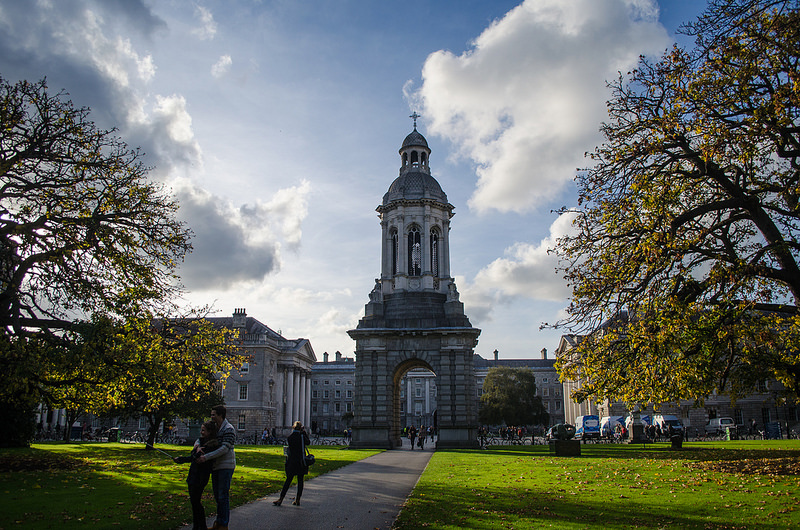Looking at the differences in Trinity between 1916 and 2016 highlights how dramatically the College has evolved in the last 100 years. In 1916, a 10-week stay in Trinity Hall only cost between £12 and £15, the Experimental Science Society had just bought their first projecting microscope with the University Biological Society and scientists in the College were just starting to receive more funding for their research. The intellectual prestige of the experimental and natural sciences has increased enormously in the preceding years. Looking at scientific research in Trinity today, this is even more so the case, with millions of euro of funding being awarded to academics in College each year – this funding has allowed laboratory automation to be improved, a better level of education can be given and ultimately, more breakthroughs in the scientific field occur. With the advancements in scientific exploration, many academic scientists look forward to the investments and funding needed to continue their research, ordering equipment from somewhere like SciQuip to continue their investigation.
Speaking to The University Times, Prof Luke O’Neill, Professor of Immunology and Biochemistry in Trinity and former director of the Trinity Biomedical Sciences Institute (TBSI), reflected on medical research in the early 20th century. Highlighting the differences in medical treatments for diseases like arthritis between 1916 and today, he explained that physicians did more harm than good with treatments such as leeches and herbal remedies. Treatments included iodine, hot sea sand and blistering the skin covering the spine and bursting them. This lasted until 1923 but, even then, many treatments were still a placebo. Putting it all into perspective, however, he notes that DNA hadn’t even been discovered at the time.
The Ireland of 1916 was in a state of emergency, and this is reflected strongly in scientific publications from Trinity at that time
The value of looking into the past is that we enjoy a deeper understanding of our present. The Ireland of 1916 was in a state of emergency, and this is reflected strongly in scientific publications from Trinity at that time. The work of these scientists consisted of penetrating abdominal wounds, fatal infectious disease and vaccination, reflecting the tumultuous atmosphere of rebellion that Ireland was experiencing.
Reflecting on this, and how the world in 2016 shapes modern research, O’Neill pointed to Africa and the developing world, the preventable deaths occurring there and organizations such as The Bill and Melinda Gates Foundation that are funding research to combat this. In the Western world, he declared, government’s approaches to an aging population are a major issue shaping current research. A policy switch in governments towards the aging population is predicted.
Captain HT Bates, a medical graduate of Trinity, researched the operative results of penetrating wounds to the abdomen as part of his work in the British Expeditionary Force. His paper details the treatment and results of 60 patients who presented with various penetrating abdominal wounds mainly caused by bullets and bomb explosions. In the paper, Bates details a member of the Irish Guards who was “shot at close range by a machine-gun bullet”. The resulting operation saw the patient lose “four feet of intestine”. The operation was successful, and Bates concluded that this sort of procedure was appropriate for such injuries except in the case of complicated wounds. While now it is generally believed that the quicker you operate, the better, it was also remarked that, where possible, it would be appropriate to leave one or two hours between admission and surgery to allow the patient’s state of shock to subside. This is in stark contrast to the current research taking place in Trinity which reflects a much more optimistic scientific era in areas of modern medicine, vaccination and medical genetics.
This year, discoveries in medical genetics have indicated potential novel therapies for psoriasis, a chronic inflammatory skin disease. Prof Séamus Martin’s group from Trinity’s Smurfit Institute of Genetics have discovered how IL-36, an “immune SOS signal”, can cause the immune system to switch on. IL-36 causes inflammation at the site of injury or infection, allowing immune cells to flock to the site and clear any invading pathogens. Martin and his team have discovered the molecules that activate IL-36 that are overactive in the skin of people that suffer from psoriasis, suggesting an entirely new way of treating the condition. Psoriasis itself has only really been studied as an autoimmune condition in the last 50 years, showing how progressive scientific research has become in the last century.
Speaking about the work going on in his own lab, O’Neill jokingly described his work as “solving the mysteries of the immune system”. He has spent his career focusing on inflammation, the process at the heart of many diseases. He hopes that his lab will pinpoint specific pathways that could be targeted with new anti-inflammatory drugs for big diseases such as Alzheimer’s and Parkinson’s while also looking into the inner workings of immunometabolism.
Another major issue affecting the health of people in 1916 was pulmonary tuberculosis (TB), a degenerative bacterial disease of the lungs. Today, while the disease is no longer a major threat to the Irish public, research into TB is ongoing in Trinity.
Antibiotic resistance is a massive threat to public health worldwide exemplifying the need for new antimicrobial treatments such as vaccines against multidrug-resistant pathogens
Causing an average of 1.5 million deaths each year out of about eight million cases, Ireland sees about 400 TB cases each year. Many of them show multiple-drug resistance to antibiotics.
A team from Trinity and St James’s Hospital, led by Dr Clíona Ní Cheallaigh, have made a breakthrough in terms of how our immune system responds to TB, which opens up the possibility to design more effective vaccines and personalized therapies. The team have discovered that a protein called Mal is highly variable between people. Having a different form of Mal impacts how well people respond to TB as it signals another important molecule that, in turn, causes an inflammatory response to clear the infection. The drug resistance capabilities of TB mirror that of many major diseases. Antibiotic resistance is a massive threat to public health worldwide exemplifying the need for new antimicrobial treatments such as vaccines against multidrug-resistant pathogens.
In our lifetimes, many of us have seen pandemics such as Ebola and Zika. These diseases are caused by viruses and can only be controlled by vaccination. In 1916, Thomas T O’Farrell, assistant professor in pathology in University College Dublin (UCD), investigated the agglutinating power of sera, a component of our blood. Whether the sera clumped or agglutinated would indicate the presence of an antibody-antigen complex. The samples came from the Irish military men who had received, for the most part, typhoid vaccines. This research had great importantance in terms of the vaccination movement as it furthered the understanding of the typhoid vaccine.
Vaccines contain substances called adjuvants, which enhance our body’s immune response to vaccination, and we are only beginning to understand them. O’Neill remarked that, up until 15 years ago, adjuvancy was ignored. The development of new adjuvants is essential to produce new vaccines against diseases. Professor in Immunology Ed Lavelle, from Trinity’s School of Biochemistry & Immunology and Amber, the materials science centre in Trinity, and Dr Elizabeth Carroll have discovered the mechanism by which chitosan, a vaccine adjuvant, works. Other vaccine work going on in the school involves Dr Rachel McLoughlin, who is in the process of discovering a vaccine that will work against MRSA.
These new scientific insights into the treatment of such common and invasive diseases are something that would have seemed impossible 100 years ago. We can see there has been a shift towards the nanoscopic and a new wave of advanced and sophisticated research has begun. The potential for therapies arising from Trinity-led research reflects the impact that our scientists have, not just on Ireland but on the entire world. Vaccination has seen the eradication of smallpox and soon poliovirus. The immune system is being harnessed in a way 1916 scientists may have never thought possible.
Speaking to The University Times, Cliona O’Farrelly, Professor of Comparative Immunology in the School of Biochemistry and Immunology, described how our outlook has changed. “100 years ago, people thought that immune system ‘only’ fought against pathogens. Now we know it has a whole lot of other functions including role in tumour surveillance, metabolism, and reproduction”, she explained. One project that O’Farrelly and her colleagues are currently working on is looking at how cell populations in the uterus are important for a successful pregnancy.
“We have found that poor NK [natural killer cells which act as a defence cells in the immune system] differentiation in the uterus is because of low levels of stem cell factor. So maybe if we could find a way of stimulating SCF [stem cell factor which is involved in embryo development] we could find a new way of helping the thousands of women who have difficulty getting pregnant,” she said. This highlights how far advancements in science and healthcare have come – an achievement in which Trinity has played a vital part, and will continue to do so in the future.
The rate of advance of knowledge from what we had in the 1950s has been huge
When asked his vision for 100 years time, O’Neill made the bold statement that “all diseases will be cured”, echoing Mark Zuckerberg. He says that the rate of advance of knowledge from what we had in the 1950s has been huge. We understand much more now about how the body works and how diseases develop.
O’Neill explained the importance of gene-editing advances that have been made. He predicted that diseases that have a purely genetic component – like Cystic Fibrosis – could be completely cured with this method. Even diseases with a partially-genetic basis, such as rheumatoid arthritis, can be treated in this way. As there is currently no known cure for rheumatoid arthritis, it is important that people who are suffering from this disease have treatments provided to them so that they’re able to manage it. For example, this method, alongside alternative medications like CBD oil that can be found at places similar to Blessed CBD, will be able to help ease the painful symptoms and the suffering of this debilitating condition. Advances in tissue engineering may even allow us to clone our own organs. O’Neill noted that this means we will be able to “keep reinventing ourselves as we get older. There’s no reason we can’t take a skin cell, and reprogramme it back into a stem cell and grow it into a specific organ for storage”, also joking that “the brain might be a bit trickier”.
If these predictions come to fruition, most of the remaining diseases to be cured will be those of aging, such as Alzheimer’s. He believes that we will be able to slow down the onset of these diseases by understanding the mechanisms that drive them, citing his own work and referring to it as “not that far from science fiction”. He hoped that these pathologies, which may not be cured, will at least be treatable. He predicted an increase in personalized medicine in the future, with certain medicines being prescribed to different people depending on how they respond to them. In 100 years, he joked, people will look back on 2016 and say “what do you mean you couldn’t treat cancer?”







